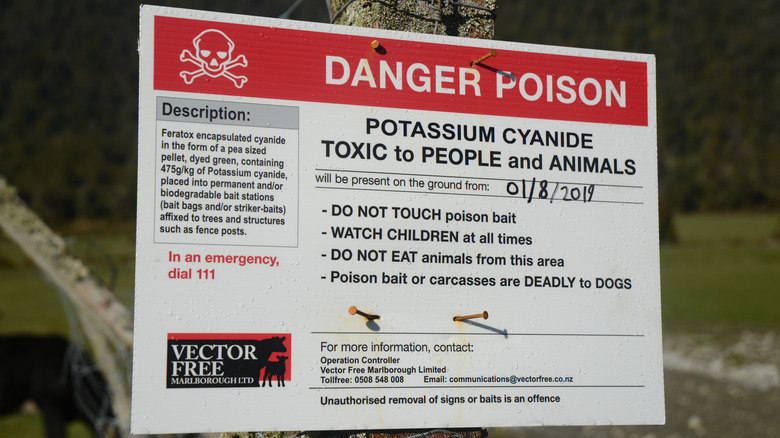This Is What Happens To Your Body When You Ingest Cyanide
If you've ever read a mystery novel or seen a spy flick on TV, you probably have some idea of what cyanide is. The darkly mysterious poison has long been a favorite murder weapon for jilted lovers, infamous assassins, and anyone whose goal is to discretely slip the substance into their victim's food or drink for a quick and undetectable death. While we all know we certainly don't want any cyanide to enter our system, not many of us know what actually happens to the human body when cyanide is ingested. As it turns out, the answer isn't pretty.
Cyanide poison is actually a catch-all term for four different, potentially deadly chemicals: sodium cyanide (NaCN), potassium cyanide (KCN), hydrogen cyanide (HCN), and cyanogen chloride, according to Healthline. However, cyanide itself is simply any chemical that contains a carbon-nitrogen bond, and it can be found in small amounts in a number of common places, including healthy foods like almonds, spinach, and lima beans, and ordinary medicines like the antacid Cimetidine and the antidepressant Citalopram.
Cyanide poisoning can be acute or chronic
When we think of someone being maliciously poisoning with cyanide, as in a movie, we are most likely thinking of the two crystallized solid forms, potassium cyanide and sodium cyanide, according to Emedicine Health. It is fast-acting, colorless, and has a generally weak odor, which is what makes it such a popular method of murder (via the CDC). However, cyanide poisoning can also happen if someone comes into contact with hydrogen cyanide, which is a gas. Cyanide gas poisoning is most likely to happen when someone inhales smoke from a fire, although it is also present in cigarette smoke, as well as other materials like pesticides, plastics, and other synthetic materials.
Ingesting large amounts of the poison at one time will cause acute cyanide poisoning, which is severe and usually immediately life-threatening. Chronic cyanide poison, on the other hand, can occur if a person is exposed to lower amounts of the substance over time, such as through exposure to water, soil, or air that has been contaminated with the substance. Symptoms of chronic cyanide poisoning will appear gradually, and long-term exposure can lead to chronic nerve, heart, and brain damage, per the CDC.
Cyanide poisoning is rare
If a person has ingested cyanide, they will begin to feel weak, confused, dizzy, nauseous, and drowsy. Their pupils will dilate, their skin will turn cherry red, while their lips or face may turn blue, and their heartbeat and breathing will become irregular. Headaches, vomiting, convulsions, abdominal pain, and erratic behavior are also common symptoms. In extreme cases, they may suffer a seizure or cardiac arrest, or slip into a coma, per Healthline. Although symptoms of acute poisoning are usually easily detectable, they also mimic the symptoms of other illnesses, which can make it difficult to know if someone has been poisoned. If an individual is suffering from cyanide poisoning, emergency medical attention is needed immediately. A person suffering from cyanide poisoning may be treated with any oxygen mask, activated charcoal, which absorbs the toxins, and the antidote hydroxocobalamin may be administered to help neutralize the cyanide and detoxify the liver.
Unlike what the movies may have you believe, acute cyanide poisoning is an extremely rare and usually accidental occurrence (per Healthline). Although it may be a favorite way for dramatic actresses to be rid of their wayward husbands on the silver screen, in real life, most victims of toxic cyanide poisoning are unintentionally exposed to toxic amounts while working in high risk fields where they deal with the substance, such as metallurgy, manufacturing, photography, fumigation, or chemists in a laboratory.


